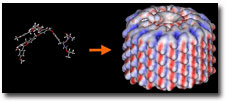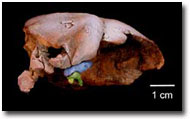 |

|
 |
 |
The University of Pennsylvania group has discovered a variety of small, protein-like molecules (left) that will assemble themselves into molecular-scale channels, or "pores" (right). In the process, the molecules form a helical pattern much like that found in natural pores.
Credit: Virgil Percec laboratory, University of Pennsylvania
|
The Hole Story—University of Pennsylvania chemists create artificial Molecular "Pores"
Researchers at the University of Pennsylvania have created the first artificial analogs of nature's molecular "pores"—the tiny, hollow channels that perform a multitude of essential tasks in living cells. Writing in the August 12, 2004, issue of the journal Nature, Penn chemist Virgil Percec and his colleagues, partially supported by the National Science Foundation (NSF) in their study, note that natural pores are used by the cell to transport certain molecules across the cell membrane, as well as to generate chemical energy, guide the shape of newly-made proteins, and even puncture holes in the cell walls of hostile bacteria.
More...
(posted August 19, 2004)
|
 |
|
 |
The EarthScope rig currently drilling into the San Andreas Fault. The rig will be part of the September 2nd tour.
Credit: EarthScope Project
|
Geologists Host Tour Of San Andreas Fault On Sept. 2nd —EarthScope
Project Scientists Lead Modern-Day 'Journey to the Center of the
Earth'
In a modern-day journey to the center of the Earth, geologists are exploring the structure and evolution of the North American continent at scales from hundreds of kilometers to less than a millimeter - from the structure of a continent, to individual faults, earthquakes and volcanoes. The project is called EarthScope. With approximately $200 million in funding from the National Science Foundation (NSF), EarthScope will be developed over the next five years. The project is expected to operate for an additional 15 years. On Sept. 2, scientists studying San Andreas Fault geology will provide a first look at the multiple technologies EarthScope will use to explore the structure and tectonics of North America.
More...
(posted August 19, 2004)

|
 |
|
Frontiers Spotlights NSF-Supported Discoveries, Research Results
NSF's investments in science, engineering, education and technology help to create knowledge and sustain prosperity. Now our updated Frontiers website presents the stories behind some of the results made possible by NSF's investments, conveying the meaning and the thrill of discovery to all audiences. Find out about: researchers who are developing an artificial retina to restore partial sight; the origins of Web browsers and a popular Web search engine; discoveries of powerful toxins that may someday help fight disease in humans; work on a new method of visualization that sheds light on objects as tiny as proteins in a cell membrane; searches for planets outside of our solar system; and much more. Once you've spent time on our Frontiers of science and engineering, you'll understand why we say NSF is where discoveries begin.
Visit Frontiers at http://www.nsf.gov/od/lpa/frontiers/
(posted August 19, 2004)

|
 |
|
 |
Middle ear of the fossil whale Remingtonocetus from India, approximately 43-46 million years old. The tympanic bone is seen from above, as it is cradling two of the ear ossicles, the malleus and incus (blue and green respectively, in false colors).
Credit: Artwork by Lauren Stevens
|
Evolution of Whale Hearing Unfolds in Fossil Record
An international team of scientists has traced the evolution of hearing in modern cetaceans (whales, dolphins and porpoises). "This study of the early evolution of whales demonstrates the changes that took place in whales' outer and middle ears, required for the transition from a land-based to a marine-based existence," said Rich Lane, director of the National Science Foundation (NSF)'s geology and paleontology program, which funded the research.
The findings are published in the Aug. 12 issue of the journal Nature.
More...
(posted August 19, 2004)

|
 |
| |

|

